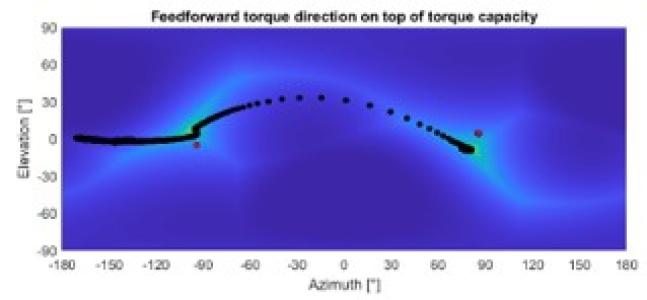Attitude Guidance Using On-Board Optimisation

Demonstrate on-board real-time fuel, power or time optimal and robust attitude guidance using optimisation techniques in presence of exclusion zone constraints and non-uniform actuator authority envelopes.
Recent developments in optimisation formulation and software design have allowed multi-criteria optimisation problems to be solved in real-time on typical space-grade processors. An important potential application is slew attitude guidance in the presence of actuator limitations and star tracker or instrument exclusion zones, particularly when slew time is critical.The optimisation problem can be formulated as time, fuel or pointing error (during slew) minimisation with constraints of exclusion zones and actuator authority envelopes. The non-convex problem can then be convexified with certain assumptions, and compiled into a convex optimisation solver. This would then be integrated into flight software and solved either at slew start time, as a path planner making use of state knowledge just prior to the slew, or continuously during the slew, as in model predictive control.Real-time optimisation solvers will bring robustness to time-critical missions such as comet fly-by (ESA?s Comet Interceptor mission), where actuator authority, managed by standard algorithms, may be insufficient due to design constraints, unexpected actuator failure or impacts of large dust particles. With on-board guidance optimisation, the attitude profile can be altered in real-time to minimise the visual/IR science outage within the constraints of the wheel initial conditions, actuator authority limits and instrument sun exclusion zones.These same solvers, with different costs and constraints, could reduce time-to-target in Gamma-ray burst tracking missions (like ESA?s Theseus), where slew-duration reduction can significantly benefit the science return or provide extra agility without extending the actuator capacity. Potential benefits are greater for large slew angles where simple ad-hoc planning algorithms may select sub-optimal slew paths. These are some examples of types of missions that may benefit from this technology, but the total set of possible applications is far more widespread. A first stepping stone for industry could be to use convex optimisation as a reference solution for evaluating classical algorithms during phase A/B design and for actuator sizing excercises for complex problems where analytical solutions are not available.For adoption on future ESA science missions, it is important that the technology be demonstrated on a flight-like processor for flight-like problems. Several example cases will be defined for the study which will assess the best convex optimisation solutions and demonstrate adequate performance on a flight-like processor, compared with heritage techniques. Verification and validation will also be addressed.Task List:Task 1/ Literature Review (Convex Optimization and associated Verification Validation approaches)Task 2a/ Requirements Definition for several example cases(targets: THESEUS and COMET INTERCEPTOR missions)Task 2b/ Mathematical Optimisation Problems DefinitionTask 3/ Convexification Methodology SelectionTask 4/ Algorithm Tuning Preliminary Simulation ResultsTask 5a/ Test case definitionTask 5b/ Verification Validation by AnalysisTask 6/ Demonstration on Flight Processor
